October 13, 2021 Minutes
Faculty Senate Meeting Minutes (SUB Ballroom B)
10/13/21
3:10pm – 4:30pm
Please wear a mask.
|
Name |
Represents |
Attended |
|
Watson, Bradford |
Chair |
x |
| Brody, Michael |
Chair-Elect |
x |
|
Amendola, Roberta |
EN/Mechanical & Industrial Engineering |
x |
|
Brookshire, Jack |
AG/Land Resources & Environmental Sciences |
x |
|
Carson, Robert |
EHHD/Education |
x |
|
Caton, Gary |
Business |
x |
|
Coffey, Jerry-Phone |
Emeritus Faculty |
x |
|
Cowan, Susanne |
AR/Architecture |
x |
|
Dale, Catherine |
AR/Film & Photography |
x |
|
Dratz, Ed |
LS/Chemistry & Biochemistry |
x |
|
Ellis, Colter |
LS/Sociology & Anthropology |
x |
|
Flory, Dan |
LS/History & Philosophy |
x |
|
Gao, Hongwei |
EN/Electrical and Computer Engineering |
x |
|
Gedeon, Tomas |
LS/Mathematics |
x |
|
Haggerty, Julia |
LS/Earth Science |
x |
|
Hansen, Andy-Phone |
LS/Ecology |
x |
|
Haynes, George |
Extension/On Campus |
x |
|
Herman, Matthew |
LS/Native American Studies |
x |
|
Hill, Andrew |
AG/AgEcon & Econ |
x |
|
Izurieta, Clemente |
EN/Computer Science |
x |
|
Johnson, Jerry |
LS/Political Science |
x |
|
McCalla, Stephanie |
EN/Chemical Engineering |
x |
|
Moyce, Sally |
Nursing/On campus |
x |
|
Orendorff, Karie |
EHHD/Health & Human Development |
x |
|
Rebane, Aleks |
LS/Physics |
x |
|
Schmidt, Ed |
AG/Microbiology & Immunology |
x |
|
Stein, Otto |
EN/Civil Engineering |
x |
|
Stoneback, Sarah |
AR/Music |
x |
|
Tillack, Peter |
LS/Modern Languages |
x |
|
Van Emon, Megan-Phone |
AG/Animal & Range Sciences |
x |
|
ALTERNATES |
Represents |
Attended |
|
Gannon, Paul |
EN/Chemical Engineering |
x |
|
Lachapelle, Paul |
LS/Political Science |
x |
|
McKelvey, Hannah |
Library |
x |
|
OTHER ATTENDEES |
Represents |
Attended |
|
Babcock, Michael |
LS/Earth Sciences |
x |
|
Blackler, Kristin |
ASMSU/Sustainability |
x |
|
Carter, Jason |
VP REDGE |
x |
|
Leon Costello |
Athletics |
x |
|
Jamie Rizzuto |
Athletics |
x |
|
Peters, Martha |
Provost Office |
x |
|
Provost Mokwa |
Provost Office |
x |
|
Sobek, Durward |
Provost Office |
x |
|
Swinford, Steve |
Provost Office |
x |
|
Thomson, Jennifer |
Faculty Affairs |
x |
I. Call to Order
a. Meeting was called to order at 3:10pm
II. Attendance Reminder
III. Approval of FS Minutes from September 29, 2021
a. Tomas Gedeon moves to approve. Andrew Hill seconds. None opposed. No abstentions. Approved.
IV. FYI items
a. Dyslexia & Innovation Conference Oct 28 & 29
b. A Seat at the Table October 18 SUB Ballroom B
i. http://www.montana.edu/ehhd/a-seat-at-the-table.html
c. Faculty Excellence Grants due Nov 15
i. https://www.montana.edu/facultyexcellence/grantsawards/feg/
d. 2022 Awards of Excellence, submissions due November 02, 2021
i. https://www.montana.edu/provost/faculty/awards/index.html
e. Box Migration, no longer available in March 2022
i. https://www.montana.edu/uit/boxtransition/
f. Honorary Degree Nominations due Oct 29
i. https://www.montana.edu/calendar/events/39034
g. Humanities, Arts and Social Sciences internal grants
i. Scholarship & Creativity Grants Program, due October 2, 2021, and March 1, 2022, https://www.montana.edu/research/internal_awards/s_and_c_grants_fy2022.html
ii. Humanities, Arts, and Social Sciences (HASS) Grant Program, due March 1, 2022, https://www.montana.edu/research/internal_awards/hass_rfp2022.html
h. Senator Hour, Monday 11-12, and Thursday 10:30-11:30 via WebEx
V. Information Updates:
a. Committee Requests
i. Recreational Sports and Fitness Advisory Board
ii. Assessment and Outcomes Committee
A. The Assessment and Outcomes Committee leads and facilitates authentic assessment for all undergraduate and graduate degree programs. The committee reviews Annual Program Assessments that provide the strong foundation upon which Montana State University develops, identifies, and documents quality improvement plans and goals including providing the institutional reporting associated with the strategic planning objectives.
b. Email Policy
i. As a refresher, all email from montana.edu is considered a public document and only in issues of discussions of litigation, personnel, intellectual property, student privacy, etc., can those emails be withheld from release if requested.
A. The email policy that governs MSU is the Board of Regent’s policy: 1303.1
B. “MUS information technology resources are to be used by an employee for the job-related activities to which the employee is assigned. An employee should not use MUS information technology resources for private, commercial purposes, except those covered under formal agreements with the MUS.”
ii. Comments
A. None of the students use their montana.edu email. Many of the students use gmail. Why don’t we all move to gmail?
1. Students can put in a “preferred’ email address.
2. There is a difference between students and public employees.
c. Athletics Update – Leon Costello, Jamie Rizzuto, and George Haynes
i. 2020-2021
A. Avg Student-Athlete GPA=3.37
B. Students on President’s List=87
C. Students on Dean’s List=207
D. Teams with a 3.5+ GPA=7
E. Student-Athletes with Term GPA >3.0=75%
ii. Top 5 Majors of Student-Athletes
A. Business/Pre-Business (including Prof Accountancy)=69
B. Health & Human Performance=31
C. Mechanical Engineering=20
D. Psychology=18
E. Liberal Studies=17
iii. Student-Athletes by College
A. Agriculture=13
B. Arts & Architecture=5
C. Business=69
D. EHHD=57
E. Engineering=67
F. Letters & Science=84
G. University College-15
H. Nursing=10
I. Grand Total=320
iv. 2020-2021 Athletics Items of Note
A. Hired Brent Vigen as Football Coach
B. Hired Adam St. Pierre as Nordic Ski Coach and Kris Shampeny as Alpine Coach
C. NCAA Name, Image, Likeness
1. Companies can now use an athlete’s name in a promotion and can pay athletes to promote their product.
2. MSU has no say in what they get paid, or who gets paid
3. Some get paid in sandwiches
4. More legislation should come out soon
5. Biggest one so far was $5,000
6. Cannot promote alcohol, gambling, etc. We are monitoring those types of things.
7. Partnering with JJCBE to work with student athletes to make sure they get what they need and deserve.
8. Partnering with other student-run operations as much as possible to get real world experience.
D. Rodeo in Athletics
E. Restructuring within Athletics
1. With Camie leaving, we have had to restructure
2. Make sure internal operations are working correctly
F. Completion of BAC
1. Football back in its “home” across Kagy
2. First floor is support for student athletes
3. Can help more students in a timely manner so students have more time to take care of themselves and their schoolwork.
4. Tutoring rooms, group study space
5. Grand Opening for Home Coming
6. 100% privately donated funds.
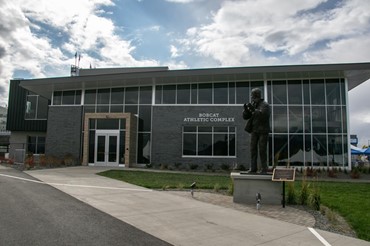
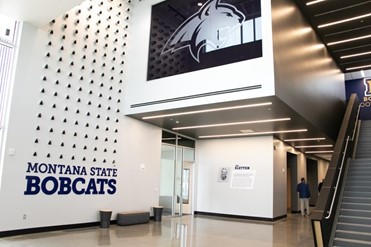
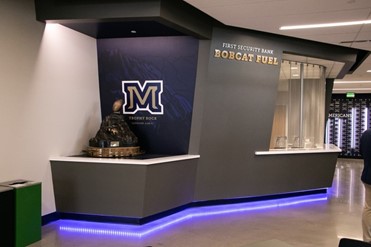

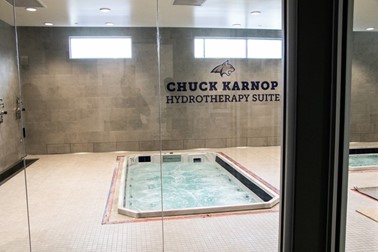

v. Questions
A. None
d. Research Update – Jason Carter, Vice President for Research, Economic Development &
Graduate Education
i. REDGE Year-In-Review
Preliminary Report to University Senate
October 13, 2021
A. Montana State research expenditures hit record high
1. FY21 Total Research Expenditures=$193M
2. FY21 Sponsored Research= +15%
3. FY21 New Authorized Sponsored Awards= +21%
4. MSU Research: Expenditures and Portfolio
I. Working to get better at tracking our internal research expenditures.
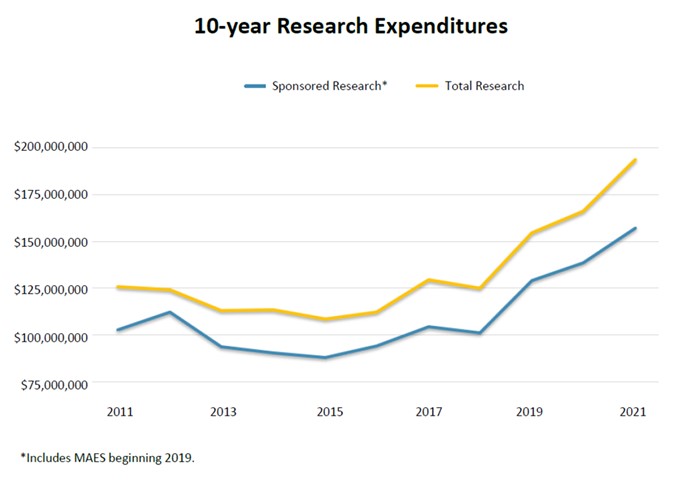
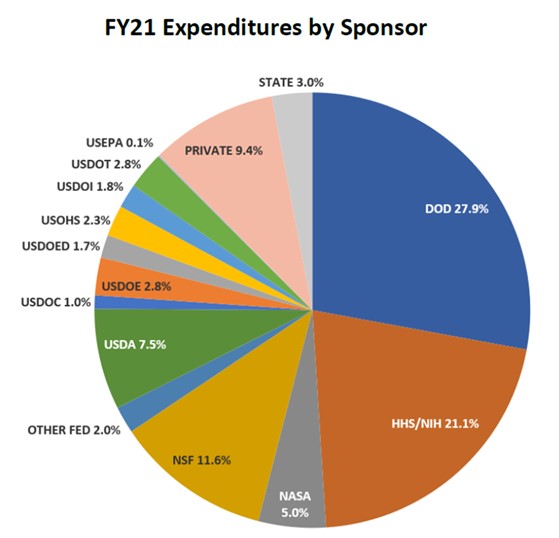
B. Watch out for changes in NSF grants
C. Supporting Montana State’s Four Grand Challenges
1. Securing the Future of Montana
2. Caring for our Environment
3. Promoting Wellness in Our Communities
4. Food and Fuel Security
D. Campus-wide presentation will highlight at least one of the following for each GC:
1. one award/project
2. one key scholarly publication/book/product
3. one faculty/researcher national or international award
4. Need your help in identifying candidates!!
E. Leveraging Partnerships: NSF MRI & Murdock Trust
1. Major Research Instrumentation: “The MRI program serves to increase access to multi-user scientific and engineering instrumentation for research and research training in our Nation’s institutions of higher education and not-for-profit scientific/engineering organizations.”
I. Track 1: $100k - $1M (limited submission; up to two applications per year)
II. Track 2: $1M – $4M (limited submission; only one application per year)
a. ~30% cost-share requirement for both
i. Can be tough to do in an institution like ours.
F. M.J. Murdock Charitable Trust
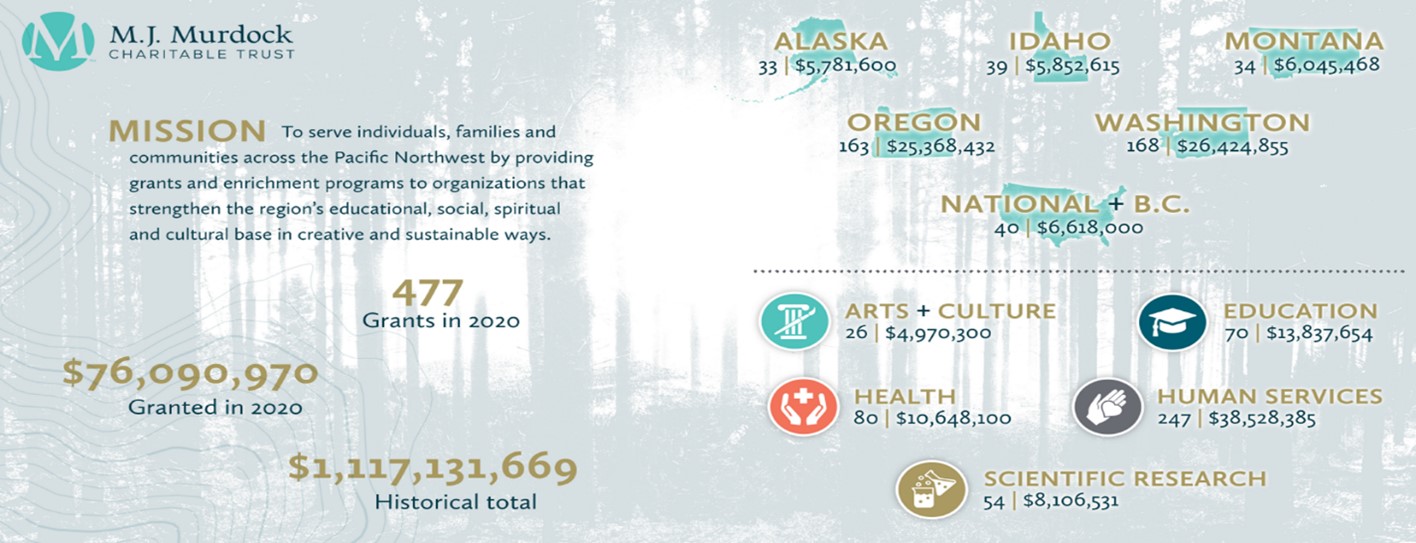 Source: 2020 Annual Report for M.J. Murdock Charitable Trust
Source: 2020 Annual Report for M.J. Murdock Charitable Trust
1. Example NSF-Murdock Partnerships
I. MSU expanding biofilm research capabilities with $513,000 grant from Murdock Trust
a. $1.5M Project (2020)
II. Innovative microscope at Montana State lets scientists explore molecules in 3-D, ultra-high resolution
a. $3.8M Project (2018)
III. $13.2M NSF MRI Awards (1991-present)
` 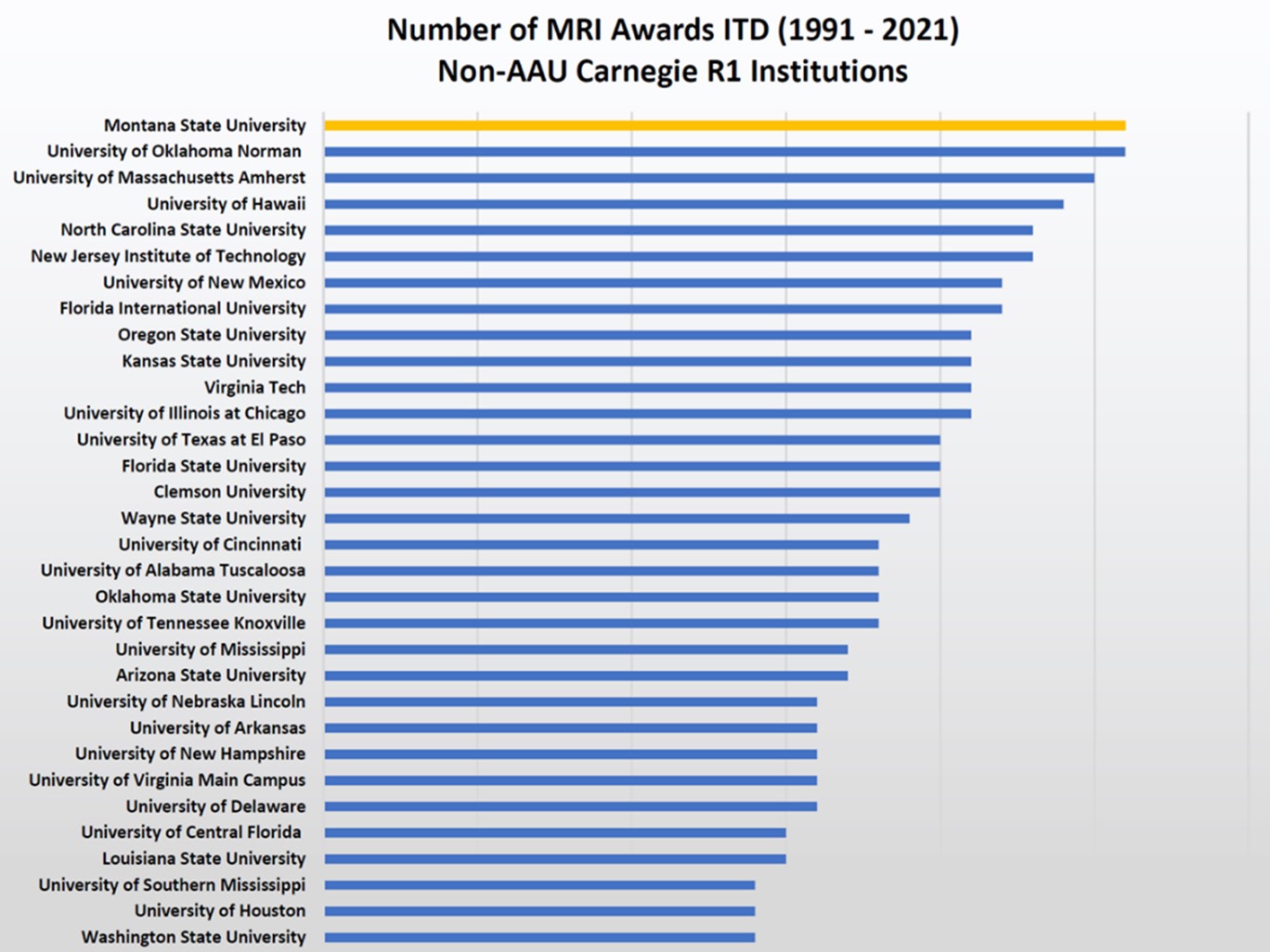
G. Montana State Universities Strategic Plan: Choosing Promise
1. Goal 1.2 Expand high quality graduate education
2. Goal 1.3 High quality, high impact teaching and learning practices
3. Goal 2.1 Enhance the significance and impact of scholarship
4. Goal 2.2 Expand interdisciplinary scholarship
5. Goal 2.3 Strengthen institutional reputation
6. Goal 2.4 Elevate expectations for scholarship
7. Goal 3.2 Grow mutually beneficial partnerships across Montana
8. Goal 3.3 Foster a culture of collaboration, continuous improvement, and individual growth
H. FY22 Priorities
1. REDGE Core Facilities Program
I. President matched us 1:1
2. Office of Research Development
3. Strategic Investments in Grand Challenges
I. Grassroots effort
II. Still working out what this will look like
4. Faculty and staff retention
I. We are all worried about this
II. Need to do better about telling you all how much we appreciate you and your hard work
5. ARL and Innovation Campus
6. TBD
e. Sustainability Framework – Julia Haggerty and Kristin Blackler, Sustainability Director
i. Will be going to University Council in November.
A. Coming to this group first. There is space for us to discuss where we fit into this framework.
ii. I am grateful for this plan. It has involved all faculty and students. We don’t recognize you enough.
iii. Humbled by the steep road we, and future generations still need to climb.
iv. Office of Sustainability
A. Established in 2012 through a student led initiative
B. Jointly funded by ASMSU
C. Division of MSU Administration and Finance
D. An “incubator” for student action
v. History
A. 2008
1. MSU joined ASUPCC
2. Campus Sustainability Advisory Council created
B. 2009
1. Students proposed sustainability fee
2. ASMSU Sustainability center created
C. 2011
1. Climate Action Plan Created
2. Stewardship goals included in the new strategic plan
D. 2012
1. ASMSU Sustainability center is restructured and becomes Office of Sustainability
E. 2016
1. Climate Action Progress Report
F. 2019
1. Choosing Promise adopted metric 3.3.6
I. Challenges to make a sustainability plan
II. Collected feedback over months
2. MSU achieves silver STARS rating
G. 2021
1. Adoption of Sustainability Framework
vi. Adoption of Campus Sustainability Framework (CSF)
A. Student demand and strong support for sustainability action!
B. Continue sustainability efforts with more visibility and resources
C. Directive to develop a Sustainability Plan contained in MSU’s Strategic Plan Goal 3.3.6 and 2008 charter to CSAC
vii. Long term targets
A. STARS Platinum 2035
1. Using the sustainability rating system provided by the Association for the Advancement of Sustainability in Higher Education, Montana State University aims to attain the highest level: Platinum.
B. Zero Waste 2035
1. Montana State University’s zero-waste target is a diversion rate of 90%. This percentage is based off the internationally recognized standard that zero-waste means achieving a diversion rate of 90% or higher.
C. Carbon Neutral 2040
1. Already on the path to carbon neutrality
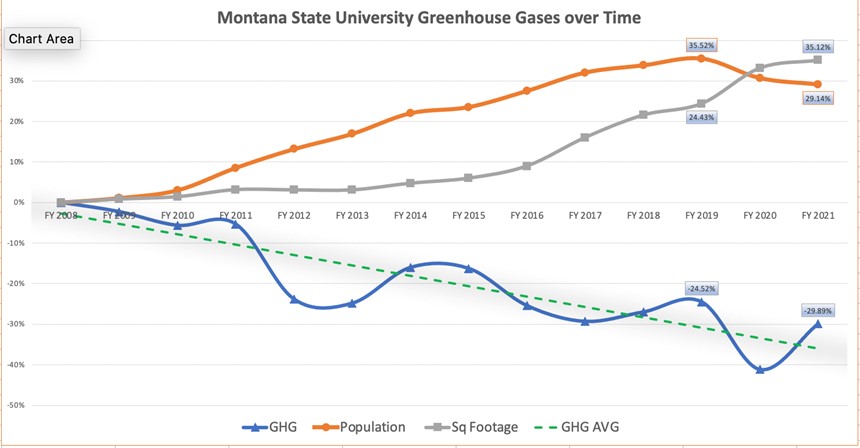
2. Carbon neutrality is achieved when the amount of greenhouse gases released is equivalent to the amount sequestered or offset. Montana State University aims to achieve this target by 2040.
viii. What is STARS?
A. STARS is a transparent, audited, self-reporting framework for universities to measure sustainability performance
B. Acts as a sustainability assessment for the entirety of campus
C. Metrics serve to monitor growth
D. Check out our report and others at www.aashe.org
ix. How can faculty senate help?
A. How do we partner together to enhance and support sustainability curriculum?
v. Conclusion
A. Special thanks to the Office of Sustainability, CSAC, and President Cruzado
B. Further resources
C. MSU faculty and students have already made many decisions towards a sustainable future, and this will help encourage the continuation of their efforts and allow us to do more!
D. Questions: please email Kristin.blackler@montana.edu or Julia.haggerty@montana.edu
1. In STARS, the most heavily weighted category is “curriculum”. That’s where the faculty can make a difference together.
2. Courses that involve sustainability. How much of the course?
I. “Sustainability inclusive” is just part of the course.
II. “Focused” is the entire course.
3. Please check that box in activity insight so we can track this information easier.
4. What are your thoughts around these types of curricular changes? Think about that
vi. Undergraduate Courses and Programs
a. Courses – First Reading
i. ASTR 372 : Stars and the Milky Way (Spring 2022)
ii. GRMN 396 : Service Learning (Spring 2022)
iii HVC 145 : HVAC-R Welding, Brazing and Pipe Joining (Spring 2022)
iv. PLUM 170 : Plumbing Codes (Spring 2022)
A. All plumbers should know what the codes are.
b Courses – Second Reading
i. ACT 241 : Introduction to Paddlesports (Spring 2022)
ii. ACT 242 : Introduction to Ice Climbing (Spring 2022)
iii. HONR 400 : Death Becomes Us: The Mystery of Mortality and the Need for Meaning (Spring 2022)
iv HVC 125 : Environmental Protection Agency 608 Certification (Spring 2022)
v HVC 130 : HVAC-R Electrical (Spring 2022)
vi HVC 140 : HVAC Systems I (Spring 2022)
vii. HVC 150 : HVAC Installation and Sheet Metal Fabrication (Spring 2022)
viii. HVC 155 : Blueprint Reading and Wiring Schematics (Spring 2022)
c. Programs – First Reading
i. None at this time.
vii. Graduate Courses and Programs
a. Courses – First Reading
i. None at this time
b. Courses – Second Reading
i. CSCI 565 : Wireless Networks and Mobile Computing-INACTIVATION
c. Programs / Certificates – First Reading
i. None at this time
d. Programs – First Reading
i. BCHM-MS : Master of Science in Biochemistry-ACCELERATED VERSION OF AN EXISTING PROGRAM
ii. CHEM-MS : Master of Science in Chemistry-ACCELERATED VERSION OF AN EXISTING PROGRAM
A Master's degrees that an undergraduate could get started before becoming a grad student.
B We will see more of these as time goes on
e. Programs – Second Reading
i. PMHC-CERT : Psychiatric Mental Health Nurse Practitioner Certificate
A. Will meet a great demand in the state of Montana.
viii. Senators’ Open Conversation
a. THEREFORE, BE IT RESOLVED that Montana State University Faculty Senate:
i. Acknowledges the urgency of the climate crisis and strengthens its commitment to taking bold climate action by joining communities and other post-secondary institutions around the world in declaring a Climate Emergency.
ii. Stresses the need for MSU to join the Presidents' Climate Leadership Commitments (formally the American College & University Presidents' Climate Commitment) and develop a comprehensive Climate Action Plan and submit annual evaluations of progress.
iii. Affirms that MSU should commit the necessary resources to ensure an immediate, rapid, and sustained response to address the climate crisis, including the initiation of an expansive and deliberate capital campaign to ensure adequate and sustained funding.
iv. Open and transparent
5. Hand out information
A. Section 1-5: Overview
B. 6 and 7 reference language in the Montana Constitution and Bozeman plan
C. 9-10 MSU’s strategic plan language
D. We have a commitment as a Land Grant Institution
E. UN Sec General: “Code Red for humanity”
F. ITTC “Evidence is unequivocal”
G. Sends a clear message to our students that the Faculty Senate understands the severity of the situation and we are committed to do something.
H. Greatest assets are our students
I. $4,000 annual
J. MSU would join consortium of other universities.
K. MSU takes the situation seriously and plans to act deliberately.
L. Need a separate resolution about funding for this
1. Recommend a capital campaign
M. Serves as a recruiting tool
1. Surging numbers of students are pursuing careers in sustainability.
2. Employment opportunities for environmental science will grow 8% in the next years.
3. Gen Z’ers are overwhelmingly worried about climate change.
I. 37% make it their number one concern
4. Others are looking at similar resolutions
II If we all work together, we come across as more serious
N. What does this accomplish?
1. Most current and available science.
2. Education that comes out of this.
3. Obligation to alert the public of the crisis that is unfolding.
I. The Prime Directive is to educate.
II. We are here to serve the people of Montana, act with conviction in the face of diversity.
III. The science is clear.
IV. The days and months ahead matter.
b. Questions?
i. Sarah Stoneback: How is this different than the sustainability framework?
A. Framework covers broad areas: transportation to waste.
B. Climate change was one of 16 goals that we discussed. This just narrows it down to climate change.
C. Funding.
1. What would the MSU campus see as a result of the funding?
II. Good question. SESAC would be those who could answer that question.
III. Focused specifically on emissions and other
D. Could it be worked into the 20/40?
1 It could, but that’s 20 years down the line. Science says we need to make immediate, rapid, and sustained emissions reductions. 10-15% annually. Would be a drastic change.
ii. Ed Schmidt: Carbon fee for air travel. How would you track this, and how would it help?
A. Utah State University made the recommendation of action items. Faculty pay a carbon offset fee.
1. A lot of opportunities to look at other universities to see what they are doing.
2. Offset fees are notoriously hard to track. It’s not the solution. Solution is reducing emissions.
iii. Please discuss this with your constituents and bring feedback to next meeting.
IX. Public Comment
a. None
X. Adjourn
a. Michael Walach moves to adjourn. Ed Schmidt seconds. Meeting was adjourned at 4:30pm
REMINDER: The next meeting will take place on Wednesday, October 27th, 2021 in Inspiration Hall-NAH.
